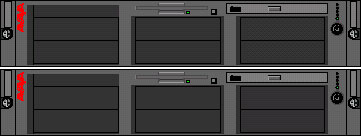Avaya S8710 Media Server
The Avaya S8710 Media Server uses a 19” rack mount, Intel Pentium 4 (3.06 GHz minimum) server running the Redhat Linux operating system. This processing engine drives the switching fabric of the system. The media server controls the switching fabric via a private Ethernet network.
The control network can be either dedicated (over a private network) or non-dedicated (over customers public network).
The voice bearer network is available in two configurations:
• Voice bearer over IP (IP-Connect): An all-IP configuration.
• Voice bearer over Asynchronous Transfer Mode (ATM) or Center Stage Switch (CSS) (Multi-Connect): In this configuration the bearer paths and control paths are separate. The control information for port networks travels over either a dedicated, through the Ethernet, switch (private LAN) or non-dedicated (over customer LAN) control network and terminates on the S8710 Media Server at one end and an IP Server Interface (IPSI) circuit pack on the other.
S8710 Media Server Control Complex
The S8710 Media Server configuration uses the following components and software:
• Duplicate S8710 Media Servers
• An IP Server Interface (IPSI) circuit pack (TN2312BP)
• An Avaya Ethernet Switch P133 or P134 or P333 or P334 or an Ethernet switch provided by customer
• An Avaya online UPS or UPS provided by <CUSTNAME>
• An Abstract Control Model (ACM) compliant Universal Serial Bus (USB) modem
• Avaya media gateways
• Avaya Communication Manager
Duplicate S8710 Media Servers
S8710 Avaya Branded Intel® Pentium Servers

The Avaya S8710 Media Server has the following characteristics:
• 3.06 GHz Pentium 4 processor
• 512 MB memory
• 72GB 10,000 RPM SCSI hard drive
• 2 10/100/1000 Ethernet ports on the motherboard to support IPSI network control links, services access, and administration
• Two USB ports, one of which you use for a modem connection and the other to connect the Compact Flash drive
• External (USB) Compact Flash
• 4-port (10/100BaseT) network interface card (quad NIC)
• A SCSI CD/DVD-ROM.
• A DAL1 Duplication board for connections to the duplicated server. A DAL1 board resides in a PCI slot on both the active server and the standby server. The DAL1 operates in either active or standby mode to match the mode of its server. When the active server saves data to its DAL1 board, the data is also sent over the fiber link to the DAL1 board on the standby server.
• A distance limitation of 10 km between the S8710 Media Servers in the pair
• Support for global power ranging from 100V to 250V AC
• Active/standby status LED (for easy in rack server identification)
• Transport of the following:
o Teletypewriter device (TTY) tone relay over the Internet
o Faxes over a corporate IP intranet
|